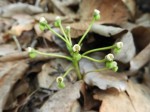Monadenium pedunculatum
Selected images: Click on each image to see a larger version and details of the record View all images (3)
Detailed records: Display species records QDS maps by: Google Maps Point records by Google Maps
Species details: Click on each item to see an explanation of that item (Note: opens a new window)
| Synonyms: |
Euphorbia neopedunculata (S.Carter) Bruyns |
| Common names: | |
| Frequency: | |
| Status: | Native |
| Description: |
Geophyte; rootstock tuberous, up to 6 cm in diameter, napiform, producing 1–2 woody stems to c. 6 cm long below ground; annual (aerial) stems 1–4, usually simple, 2–15(20) cm high, sometimes minutely papillose; leaves sessile, variable, from up to 9 × 0.5 cm and linear, or up to 6 × 1.5 cm and lanceolate, or up to 4 × 2 cm and obovate; stipules glandular, minute, evident on young growth only; cymes on peduncles up to 5(8) cm long, simple with cyme branches to 1 cm long, or cyathia solitary; bracts free, shorter than the involucre, c. 3 × 2 mm, oblong, margin denticulate; cyathia c. 5 × 3 mm, with barrel-shaped involucres; glandular rim 1.5–2 mm high, entire to crenulate, white or pink; lobes c. 1 × 1 mm, rounded; male flowers: bracteoles few, filamentous; stamens 3.2 mm long; female flower: styles 1 mm long, with thickened rugulose bifid apices; capsule c. 5 × 5.5 mm, obtusely 3-lobed, exserted on a reflexed pedicel 6–12 mm long, smooth; seeds c. 2.8 × 2.3 mm, conical with truncate base, minutely and densely verrucose, brown becoming purplish, caruncle absent. |
| Type location: |
Tanzania |
| Notes: | |
| Derivation of specific name: | pedunculatum: presumably referring to the cyme peduncles that can be up to 8 cm long. |
| Habitat: | |
| Altitude range: (metres) | |
| Flowering time: | Oct - Nov |
| Worldwide distribution: | Southeastern DRC, Burundi and southwestern Tanzania south through northeastern Zambia, Malawi and Mozambique |
| FZ divisions: | N |
| Growth form(s): | Perennial. |
| Endemic status: | |
| Red data list status: | |
| Insects associated with this species: | |
| Spot characters: | Display spot characters for this species |
| Literature: |
Carter, S. & Leach, L.C. (2001). Euphorbiaceae: subfamily Euphorbioideae: tribe Euphorbieae Flora Zambesiaca 9(5) Page 440. |
Other sources of information about Monadenium pedunculatum:
Our websites:
Flora of Malawi: Monadenium pedunculatumFlora of Zambia: Monadenium pedunculatum
External websites:
African Plants: A Photo Guide (Senckenberg): Monadenium pedunculatumAfrican Plant Database: Monadenium pedunculatum
BHL (Biodiversity Heritage Library): Monadenium pedunculatum
EOL (Encyclopedia of Life): Monadenium pedunculatum
GBIF (Global Biodiversity Information Facility): Monadenium pedunculatum
Google: Web - Images - Scholar
iNaturalist: Monadenium pedunculatum
IPNI (International Plant Names Index): Monadenium pedunculatum
JSTOR Plant Science: Monadenium pedunculatum
Mansfeld World Database of Agricultural and Horticultural Crops: Monadenium pedunculatum
Plants of the World Online: Monadenium pedunculatum
Tropicos: Monadenium pedunculatum
Wikipedia: Monadenium pedunculatum


